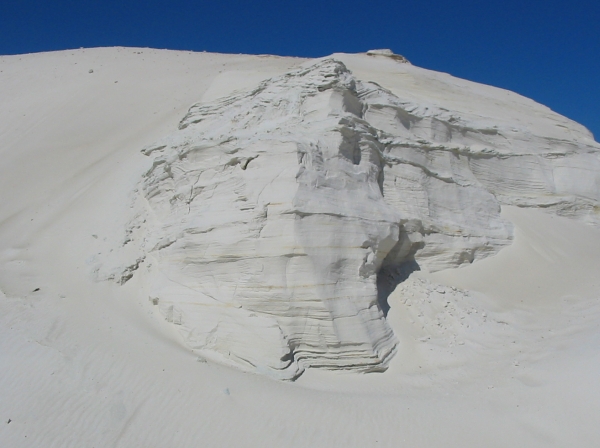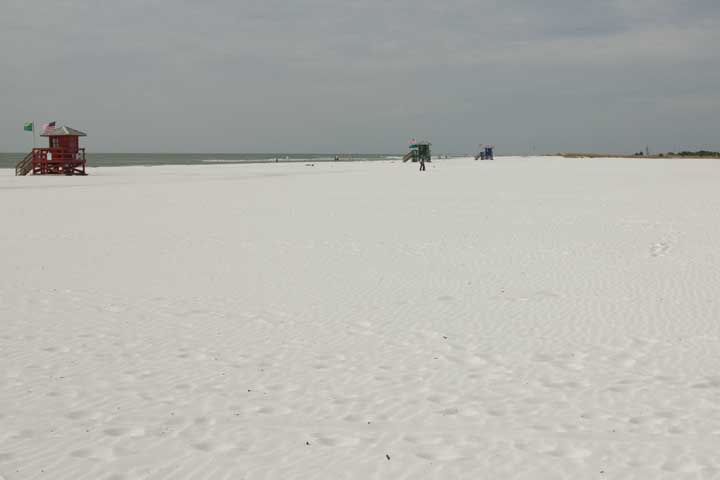What is silica? How is it related to sand? What does it mean that silica sand is made of quartz? It is not difficult to answer these questions but unfortunately the websites I checked contained some erroneous information which needs to be sorted out.

Siliceous Devonian sandstone in Estonia.
Silica or silicon dioxide (SiO2) is a chemical compound consisting of one silicon and two oxygen atoms. Quartz is a common mineral with the same chemical composition but quartz and silica are not synonyms. Specific minerals always have a definite crystal structure while chemical compounds have no such restriction — just like every piece of carbon is not a diamond. Quartz is made of silica but so are also cristobalite, tridymite and few other minerals (polymorphs of silica). They are collectively referred to as silica minerals.
Quartz is the most common sand-forming mineral. However, it is not the most common mineral in the crust. That honor goes to feldspars. If the particular sand deposit contains almost nothing but quartz, we often call it a silica sand. Such sand deposits are said to be mature because other rock-forming minerals are already broken down by the weathering process leaving only the super-resistant quartz as a residue. Silica sand is a mineral resource. It is mined mostly for glass-making. Another major use of sand is a concrete production but that does not need sand to be as pure.
Some beautiful beaches are made of silica sand. Beach of Siesta Key in Florida is especially famous for its white sand. Not all white sands are made of silica, though. White Sands National Monument in New Mexico is a dune field which is composed of sand made of gypsum. There are lots of light-colored beach sands around the world but many of them (especially in low latitudes) are made of small pieces of corals and other sea creatures. This sand is calcareous (composed of calcium carbonate) but some biogenic grains are siliceous as well. For example radiolarians (ameoboid protozoa) and diatoms (algae) have siliceous shells.
Sometimes sandstone is said to be siliceous. What does that mean? It may be a sandstone which is cemented by the silica minerals quartz or chalcedony (cryptocrystalline quartz) or it could be a sandstone which is composed predominantly of silica minerals (although sometimes feldspars are included). So you really need to dig deeper and ask critical questions if someone is talking about a siliceous sandstone as its meaning is not immediately obvious.

Beach sand in Siesta Key, Florida is almost pure silica sand (composed almost exclusively of quartz grains).
Greetings:
I am knee-deep into the 99% quartz sands of the Carolina Bays. Those enigmatic landforms were formed within a surficial sheet of quartz sands which, in North Carolina anyway, extends from the Sand Hills all the way to the coastline near Wilmington – or so says the NC State Geological Service, who examined the deposit years ago, One of the largest glass making plants in the world is located in NC and this sand is used as feedstock.
The provenance of this sand is not known, nor is it questioned. It is well established that it did not originate from the well-provenanced terraced marine deposits lying just below. It certainly must be young, as it is draped across the entire staircase from the fall line to the Atlantic shore.
What is your take on it?
I am not familiar with the local geology and I am not even sure that I understood your question correctly. I believe that the source material came from the Appalachians. 99% quartz is mature sand that has travelled quite a long way.
Greetings Slim:
Sourced from the Appalachians is a reasonable concept. My reason for questioning the provenance is that it is too coarsely skewed to have been wind blown, and it rests high up on the interfluvials – in sheets up to 10 meters deep- to have been washed down from the higher elevations. I have heard mention of hurricane force winds blowing off the glacial sheet during the last ice age. Could those winds be strong enough to drive heavy sand over long distances?
In geology it pays to go with the simplest explanation. I don’t believe in fantastic stories about hurricanes bringing sand from ice sheets. By the way, the continental icesheet even at its maximum extent was pretty far away from Carolina Bays (CB near Charleston?).